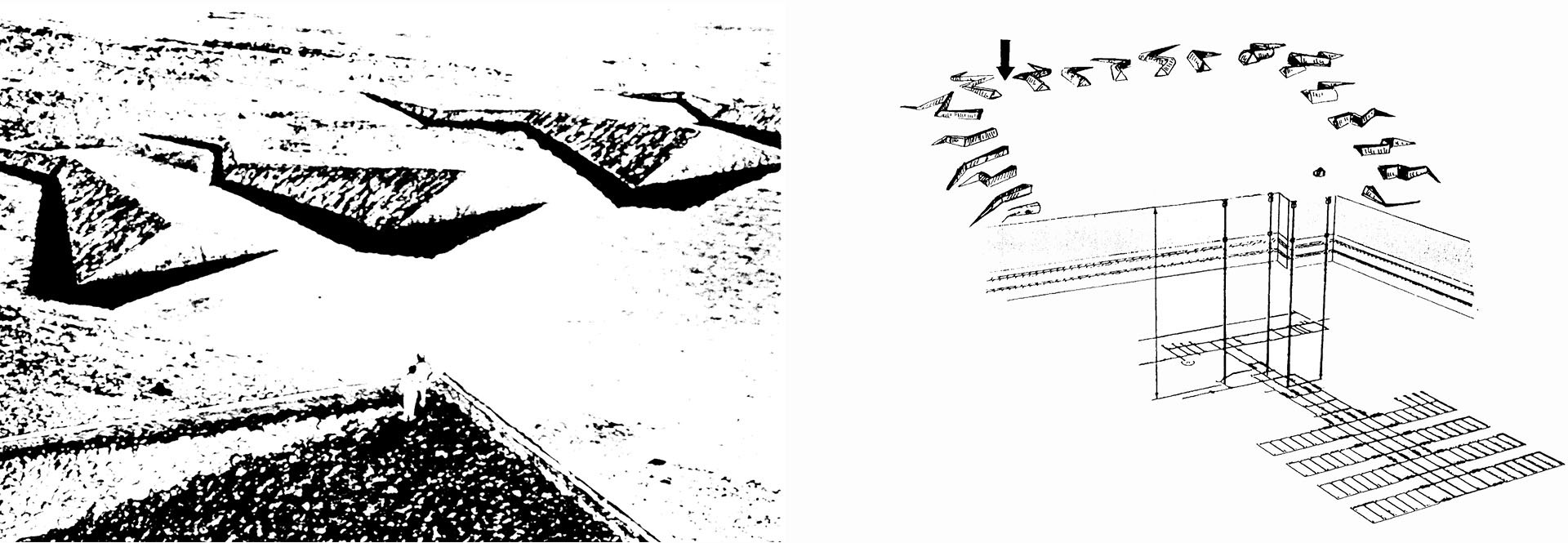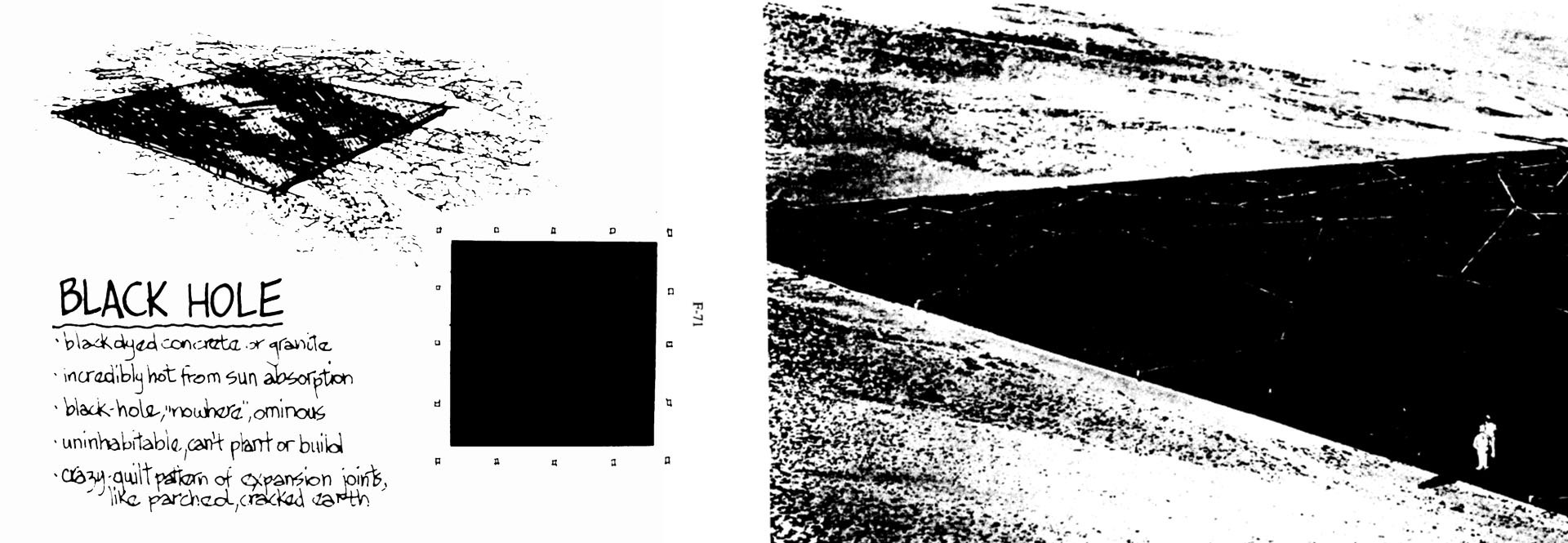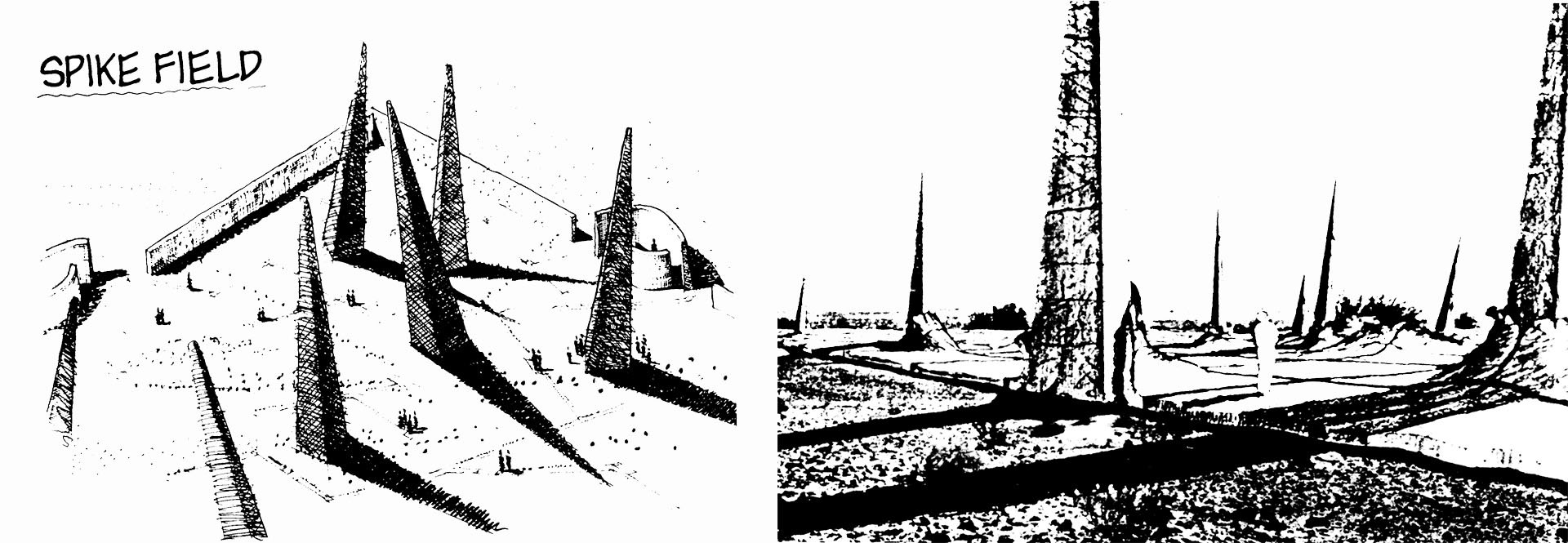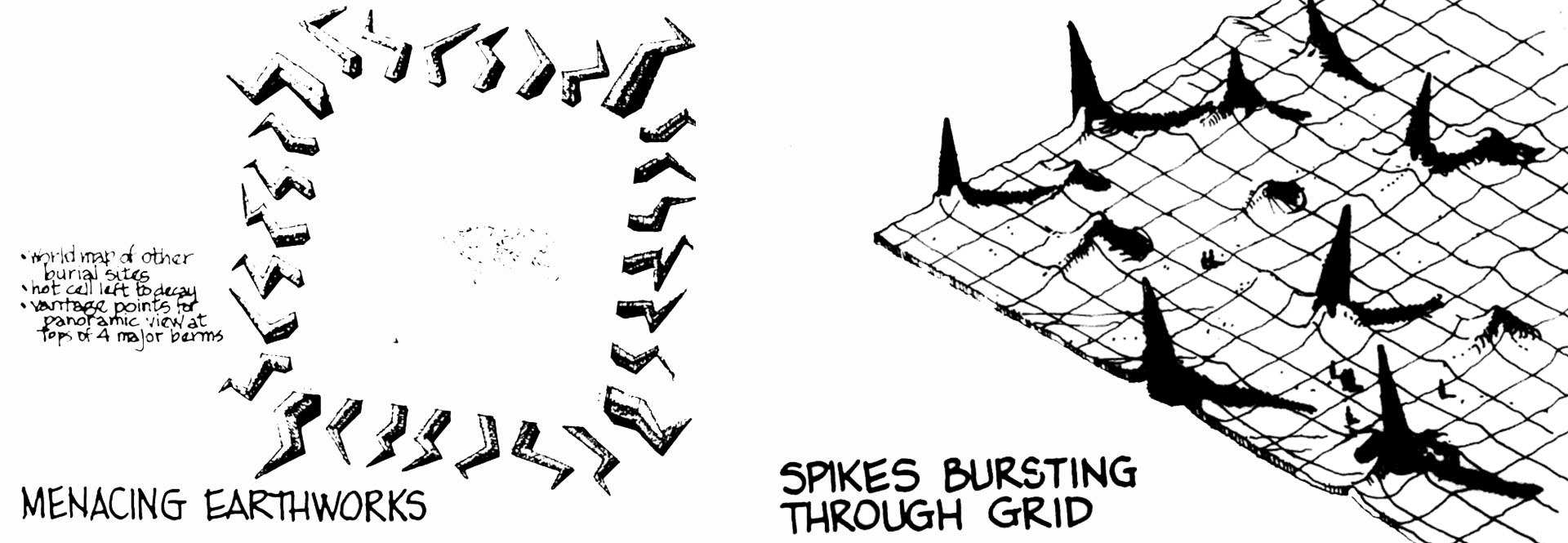The Homeland Issue
Terra Firma
Will nuclear semiotics help save future civilizations?
There is nothing for you here. As the surrounding desert expands past the horizon in every direction and you find nothing in this place but the dunes that have drifted across it slowly over millennia. Your story begins, like most, with a blank page stretched out before you. As you traverse the landscape, something strikes your eye in the distance. On the horizon, you see a line of tapering zigzag berms appear, extending from the ground toward the sky, reaching a height of nearly 10 meters. Those on either side of the monumental ridge — the left- and right-most contours — stand even taller, perhaps 15 meters in height. Approaching the berms, you discover that the line you first saw is, in fact, just one side of a square constructed from these ominous architectural sun rays, half-enshrouded by the dunes.
The inside of this alien square reflects the nothingness of the desert outside: a void space demarcated, but lost in a sea of sand. The site is peppered with curving granite kiosks that carry carved messages in various ancient, mystic scripts. You can discern the images of human faces twisted in disgust, as well as arrows pointing downward to the ground, suggesting a hazard to health below. Toward the center of the area is a small, decaying building left to ruin; beyond that, a convex, curved map surrounded by sand, depicting the world as it once was in the now-ancient 21st century.
The site described above is the expected future of the Waste Isolation Pilot Plant (WIPP), opened in 1999 in eastern Eddy County, New Mexico. It is the permanent storage site for transuranic waste, a byproduct of nuclear weapons development, which will remain radioactive for approximately 10,000 years. Because we cannot anticipate the changes in society between now and then — changes in government, language, level of technological advancement — the problem of how to warn future generations of the dangerous waste stored underground is a complex one.

In the early ‘90s, Sandia National Laboratories (SNL) sought out a solution to this problem. Owned by the Sandia Corporation (a wholly owned subsidiary of Lockheed Martin until recently; today, it is managed by Honeywell International), SNL are a set of two research and development national laboratories currently under the umbrella of the U.S. Department of Energy. With a history extending back to the days of the Manhattan Project, the labs’ purpose have been to engineer non-nuclear components of nuclear weapons. More recently, says Lockheed Martin, SNL’s research has extended into “a broad spectrum of national security issues.”
To explore solutions for warning future generations of the waste’s danger, SNL tasked two interdisciplinary teams of researchers to devise a set of design principles for marking the site in order to deter human intrusion for the next 10,000 years.¹ The teams’ efforts ultimately resulted in a 351-page report that imagines a myriad of possible futures, and speculates on how to communicate to the people living in them. Their solution: to build a space that would immediately trigger unease to impending investigators — a repulsive monument in response to the modern-day past’s manufacturing of nuclear weapons. Despite the project’s far-future intentions, the Sandia report reads to modern-day audiences as a cautionary tale, a work of speculative fiction that grapples with the near-permanent effects our actions have had on the world thus far. In fact, the report’s authors note it’s entirely possible that those actions may lead to the calamity that causes such a cultural rift between ourselves and future civilizations on Earth. This way of reading the site isn’t lost on at least one of the team members, Woodruff T. Sullivan III, who writes: “We can never know if we indeed have successfully communicated with our descendants 400 generations removed, but we can, in any case, perhaps convey an important message to ourselves.” (Trauth, Hera, & Guzowsti, 1993, p. 232)

The proposed messaging at the WIPP site, where nuclear waste is to be spurned deep underground and marked with a revolting sort of temple, evokes the image of a sealed evil — not unlike the ancient Greeks’ pit of Tartarus — radiating a dangerous, abysmal miasma from a concentrated center. Even if there is no evil creature or deity below, this act of shunning and burying tainted objects is deeply rooted in Western mythology.
In fact, assessing a burial ground for nuclear waste almost invites mythologizing; imagining the discovery of such a place thousands of years from now is a common theme in literary history — from futuristic science fiction space operas, to ancient stories of man’s descent into the underworld. James Frazer, a 19th century anthropologist (who predates the study of comparative mythology and religion by the likes of Joseph Campbell) devoted many pages in his book The Golden Bough to tribes and civilizations across the globe who transfer illness, misfortune or other evil into objects as a means of self-protection. Just like the tainted artifacts housed in the WIPP site, these objects were said to pass whatever affliction was sealed within them to any person other who touched them. Often, this evil-manifested-as-illness would be buried: according to Frazer, the people of Buganda (a subnational kingdom within Uganda) imprisoned the god Kaumpuli deep in a hole to ward off plague, of which he was regarded as the source. Later cultures would then relieve themselves of disease by imbibing it in flowers or herbs, which they would then bury (Frazer, 2009, pp. 559-561).
Because archetypal myths are endlessly resonant and reconfigured from generation to generation, Sandia’s Team A noted the importance in using archetypes to answer the question: How do we communicate with a society divorced from us through time, which almost certainly won’t speak our language?
“Archetypes have always played an essential role in human physiological, social and spiritual functioning,” the team writes, “evoking feelings of anger, aspiration, nurturing, desire, community, order, and death, to name some of the phenomena about which we still feel, think, and ponder most profoundly” (Trauth, Hera, & Guzowsti, 1993, p. 129). Archetypes’ ability to evoke these emotions in a viewer make it the foundation for the site’s basest message: Something here is manmade, and it is dangerous.

Sandia’s two teams weren’t the first to commission a study of how to deter human intrusion into a U.S. nuclear disposal site, and they weren’t the first to recommend myth and folklore as tools to achieve this. Nearly a decade before the WIPP study, the Department of Energy commissioned another “human interference task force” to answer the same question for another proposed nuclear waste site: the Yucca Mountain site in Nevada, which remains to be licensed or opened for waste disposal thirty years later.
Unlike the series of site designs that came out of the WIPP study, Yucca’s task force was focused on wackier concepts that weren’t limited to the physical site itself. One of its members, semiologist Thomas Sebeok, suggested the creation of a so-called “atomic priesthood” – a self-selecting and quasi-religious council that would deter visitors from entering Yucca Mountain using myth and superstition. The author writes that information about the site would “be launched and artifi cially passed on into the short-term and long-term future with the supplementary aid of folkloristic devices, in particular a combination of an artificially created and nurtured ritual-and-legend.” According to Sebeok, this oral tradition would pass from generation to generation. “A ritual annually renewed can be foreseen, with the legend retold year-by-year (with, presumably, slight variations)” (Sebeok, 1986, p. 168).
Of course, nonverbal communication messages can be misunderstood. Sebeok himself notes that simple superstition did not deter intrusion into burial sites such as the Egyptian pyramids, which were believed to be cursed. The difference here, though, is the creation and use of a council that is to wield some influence over people for thousands of years, evolving their mythology from generation to generation as changes in society demand it.
Similarly, while an awe-inspiring design was the Sandia team’s goal, it was important not to suggest the WIPP site could be a treasure-filled tomb or a place commemorating an honorable event. To avoid mixed messages, the team opted for “irregularity” as a design philosophy, dismissing the use of perfection as an ideal. For example, avoiding a vertical, phallic structure directly in the site’s center that might connote heroism. The Sandia team deliberately offers a place that looks just a little off, such as placing the WIPP’s “hot cell” (a safe containment chamber in which scientists can observe and manipulate radioactive materials without exposing themselves to the radioactivity) off-center.

“This shows an understanding of the ideal, but at the same time a deliberate shunning of it… suggesting we do not value this place, that it is not one that embodies our ideals” (Trauth, Hera, & Guzowsti, 1993, p. 148).
In designing the site as a message system, the Sandia team also organized a hierarchy of message levels to be placed throughout the monument. As the levels go up, so do their amount of detail: Level 1 messages contain the most general of information about the site, with Level 4 messages containing the most specific details. Levels are also organized spatially, like a set of nesting dolls that tell the story of our society. The first message is conveyed visually by the look of the entire site. Then, as a visitor is drawn towards its center, they are gradually presented with more and more detail of the site’s danger and its history.²
The Level 1 message is received when one assesses the site from afar or above. From either vantage point, it is clear that the space is human-made. The square of lightning bolt berms is unnatural in appearance, and defines a void. Upon entering the site, visitors will find curved kiosks that provide Level 2 cautionary information describing the danger below. These are written in the current official languages of the United Nations (Arabic, Chinese, English, French, Russian and Spanish). The kiosks also contain Level 3 messages, which provide basic information about the site and its history, as well as detailed descriptions of the effects that radioactive waste has on the body. On the kiosks, space is to be left for future generations to translate the messages into their own languages, writing themselves into the story.
The Level 4 messages are mostly hidden away in a series of rooms, buried underground or within the corner berms. They are to be discovered when the berms erode in the distant future, or if excavation takes place. One room won’t be hidden; the team suggests using the WIPP hot cell as a Level 4 messaging room that can be seen at any time from the surface, and which completes the visitor’s journey to the site’s center for information. These rooms will include narratives, scientific data, star charts marking the site’s date of closure, pictograms and more.
The journey from ignorance outside of the site to knowledge in its center follows classic dramatic structure of exposition, rising action, climax, denouement and conclusion prevalent in Western literature. Here, again, we imprint myth onto the space. Curious and alluring, the site’s uneasy and strange design, surrounded by the blank stretch of desert, invites all sorts of possibilities to the explorer stumbling upon it. As a controlled information system that manages its audience’s expectations — the audience here being visitors in a far-off future — the WIPP site itself has a sort of plot. More specifically, it is an exploratory science fiction drama written in the ‘90s (with all of its prejudices and privileges) to be acted out over millennia. A viewer enters the ancient site with all sorts of expectations, which are anticipated and quelled one by one as they are drawn to the center. The message system — which pulls the viewer inward to impart knowledge of a then-ancient society — is a contrasting force to the miasma below, which radiates outward from a condensed center.
As the visitor traverses the WIPP site, they symbolically climb Freytag’s pyramid of dramatic structure (based on the analysis of Greek and Shakespearean drama), meeting the climactic peak in the site’s center where all is revealed. There is no option of misunderstanding its purpose to the literate visitor. The obedient entrant 9,000 years from now may save themselves from the contagion of radioactivity, though by entering the site’s center they will inherit knowledge of a dark sin of humanity’s past (the creation and detonation of deadly weapons of mass destruction).
This mythologizing of the WIPP site perhaps has a cathartic use for present-day society. Despite the fact that the United States currently frames its nuclear weapons program as a deterrent force rather than an offensive one, unease of nuclear obliteration persists today, as seen in our response to North Korea’s maturing nuclear program.
Literary theorist Norman Holland posits that myths and archetypes get their resonance not by a mystic collective unconscious or ancient encoding of DNA; rather, they invite readers to place themselves outside of time: “the resonance we feel at myth represents a … sense of being merged into a larger matrix, a living forever in a role laid down from time immemorial” (Holland, 1989, p. 248).
If nuclear weapons bring about fear of the apocalypse, at least the waste from their production allows us to imagine a future beyond it, where our presence and past mistakes remain felt.
FOOTNOTES
¹ In this discussion, I’m assessing only Team A’s design. The majority of Team B’s suggestions are concurrent with those of Team A; where the two teams differed, Team B’s conclusions often fell prey to problems in messaging, issues Team A raised. Team A also provided a series of conceptual designs for the WIPP site — only one of which we are studying here — while Team B provided no specific designs, offering just a set of design principles instead.
² While it’s unlikely the average visitor to the site in the far-future will be capable of reading messages in today’s languages, it’s assumed that scholars who can decipher the text would exist. The Level 1 message, then, is for laymen — the following levels are intended for scientists and scholars who would undoubtedly take interest in such a discovery, depending on how far in the future that is.
Frazer, James George, and Robert Fraser. The golden bough: a study in magic and religion. Oxford: Oxford U Press, 2009. Print.
Holland, Norman Norwood. The dynamics of literary response. New York: Columbia U Press, 1989. Print.
Sebeok, Thomas A. I Think I Am a Verb: More Contributions to the Doctrine of Signs. New York: Plenum Press, 1986. Print.
Trauth, K.m., S.c. Hora, and R.v. Guzowski. "Expert judgment on markers to deter inadvertent human intrusion into the Waste Isolation Pilot Plant." (1993): n. pag. Web.
Ten Thousand Years (Podcast: 99% Invisible)
What Does the U.S. Do with Nuclear Waste? (Scientific American)
What the Earth Will Be Like in 10,000 Years, According to Scientists (Washington Post)
Joe Sutton is a writer based in Brooklyn and began his beetle-raising hobby in 2017. Follow him on Twitter.
Hero Image: Silica Magazine
Illustrations: Michael Brill and Safdar Abidi after Sandia National Laboratories for the United States Department of Energy